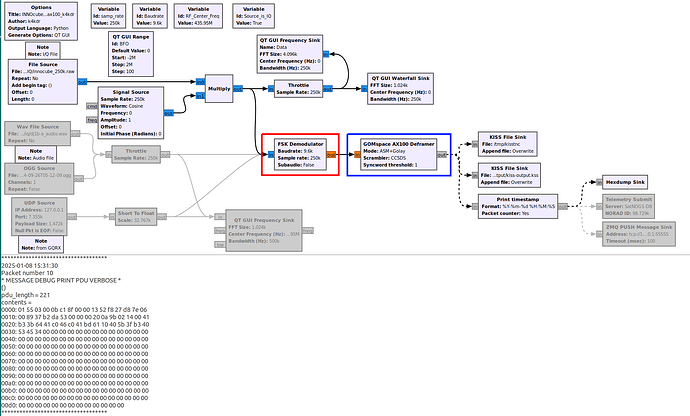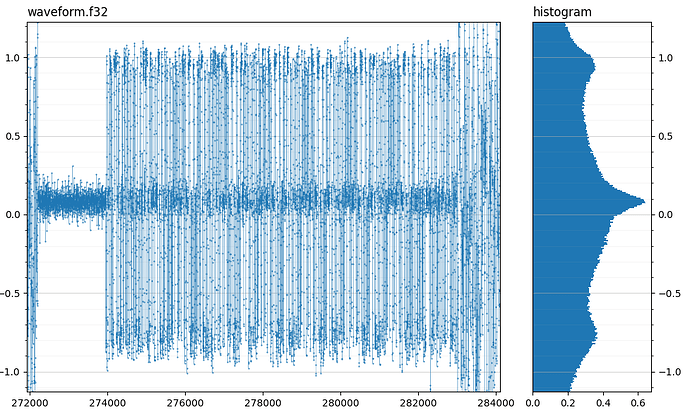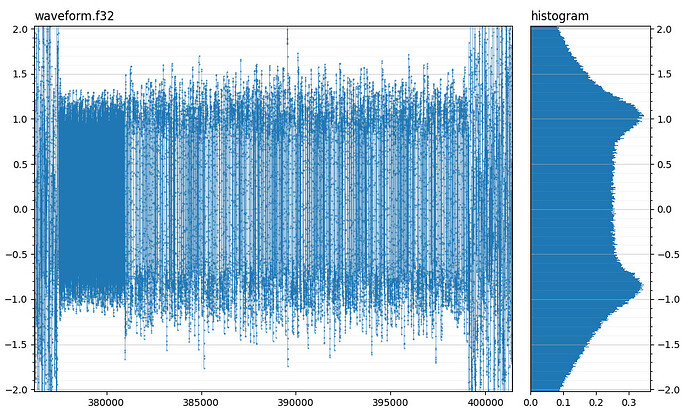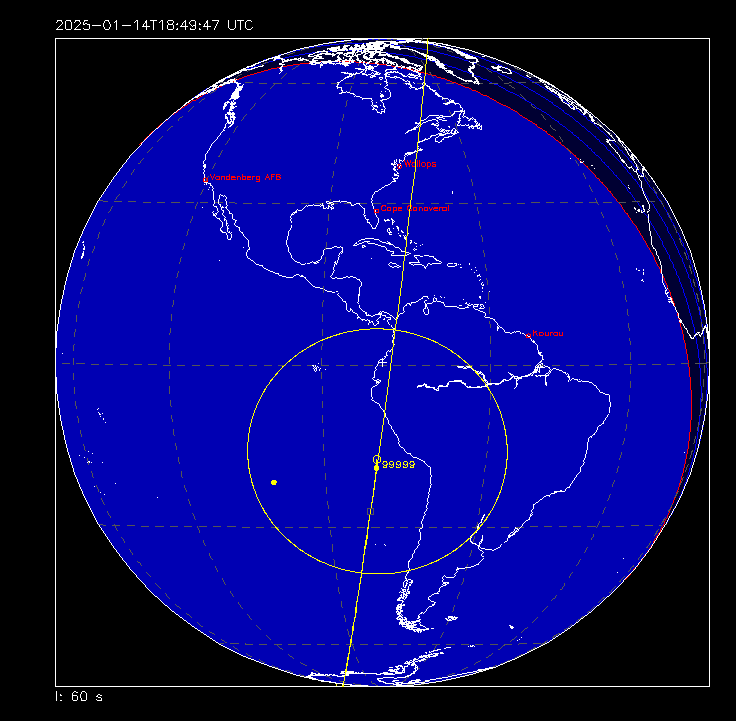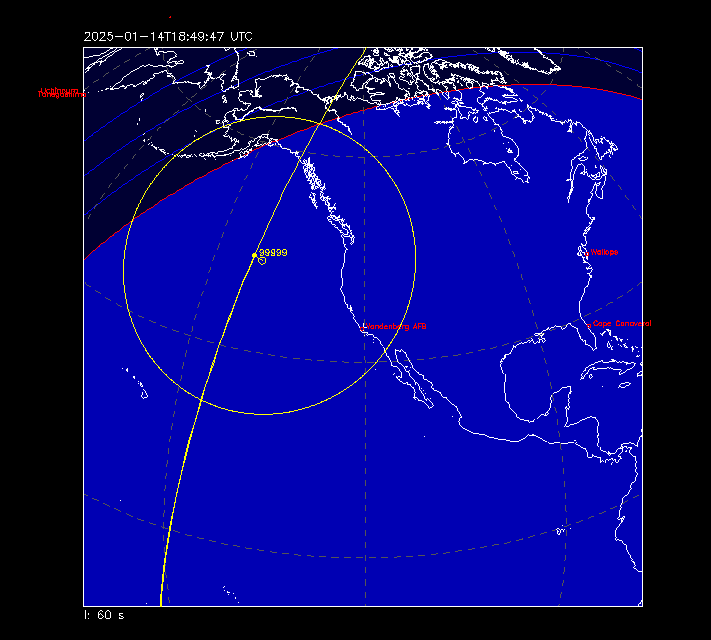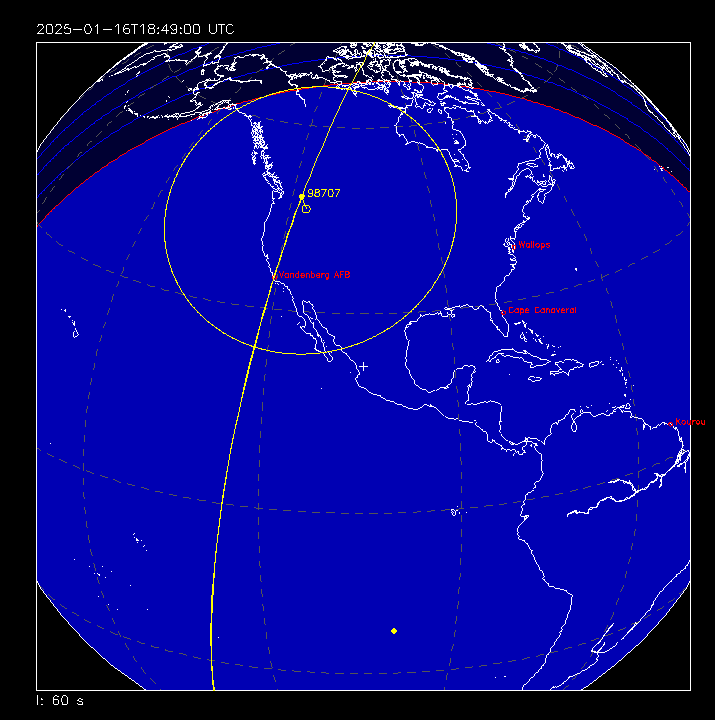PE0SAT
January 6, 2025, 11:23pm
1
SpaceX Transporter-12 Rideshare launch.
This topic will share information on the coming Transporter-12 launch.
Latest Update: 2025-01-22 11:45 UTC
Temporary NORAD ID
Satellite
Frequency
Notes
Deployed
AMATEUR VHF
98707 PARUS-T1
145.825 MHz
IARU Coordinated Directly
COMMERCIAL UHF
98659 Unknown T12 satellite 1
400.200 MHz
Frequency based on observations
Directly
98688 ELEVATION-1
400.200 MHz
ITU Entry Directly
98691 Centauri 8
400.220 MHz
Frequency based on previous missions
Directly
98697 ALAINSAT-1
400.260 MHz
ITU Entry Exolaunch Directly
98671 SATURNIN-1
400.575 MHz
ITU Entry Directly
98661 Sedna-2
400.575 MHz
ITU Entry D-orbit
98661 Sedna-2
400.625 MHz
ITU Entry D-Orbit
98697 ALAINSAT-1
400.650 MHz
ITU Entry Directly
98697 ALAINSAT-1
400.850 MHz
ITU Entry Directly
98663 BLUEBON
400.850 MHz
ITU Entry IMPULSE-2
98677 IRIS-F2
400.915 MHz
ITU Entry Exolaunch Directly
98676 IRIS-F3
400.915 MHz
ITU Entry Exolaunch Directly
98690 SKYBEE-A01
401.050 MHz
ITU Entry Directly
98657 SKYLINK-1
401.075 MHz
OTV ION SCV-016
98656 SKYLINK-2
401.075 MHz
OTV ION SCV-016
98695 BALKAN-1
401.360 MHz
ITU Entry Exolaunch Directly
98669 ION SCV-014
401.415 MHz
ITU Entry Directly
98668 ION SCV-016
401.415 MHz
ITU Entry Directly
98671 SATURNIN-1
401.500 MHz
ITU Entry Directly
98700 ConnectaIoT-5
401.510 MHz
Frequency by the team
Exolaunch Directly
98701 ConnectaIoT-6
401.520 MHz
Frequency by the team
Exolaunch Directly
98702 ConnectaIoT-7
401.530 MHz
Frequency by the team
Exolaunch Directly
98703 ConnectaIoT-8
401.540 MHz
Frequency by the team
Exolaunch Directly
98683 FOSSASAT-2E18
401.700 MHz
ITU Entry Directly
98682 FOSSASAT-2E19
401.700 MHz
ITU Entry Directly
98694 BRO-16
401.735 MHz
ITU Entry Directly
98696 ANSER Leaser-S
401.850 MHz
ITU Entry Directly
98666 TechEdSat-22
401.875 MHz
ITU Entry Directly
AMATEUR UHF
98709 INNOCube
435.950 MHz
IARU Coordinated Exolaunch Directly
98704 HCT-SAT1
436.200 MHz
Not IARU Coordinated
Directly
98707 PARUS-T1
436.850 MHz
IARU Coordinated Directly
98710 HADES-R
436.888 MHz
IARU Coordinated OTV ION SCV-016
98709 INNOCube
437.020 MHz
IARU Coordinated Exolaunch Directly
98706 POQUITO
437.050 MHz
IARU Coordinated OTV ION SCV-016
98705 PROMETHEUS-1
437.400 MHz
IARU Coordinated OTV ION SCV-016
98708 HYPE
437.400 MHz
IARU Coordinated OTV ION SCV-016
OTHER FREQUENCIES (UHF, S-band)
98698 AE1c
922.000 MHz
ITU Entry Directly
98699 AE1d
922.000 MHz
ITU Entry Directly
98681 FUSSION-1
922.000 MHz
ITU Entry Directly
98695 BALKAN-1
2102.500 MHz
ITU Entry Exolaunch Directly
98696 ANSER Leaser-S
2204.525 MHz
ITU Entry Directly
98679 IMPULSE-2 MIRA
2221.000 MHz
ITU Entry Directly
98667 SIGI
2222.500 MHz
ITU Entry Directly
98698 AE1c
2228.000 MHz
ITU Entry Directly
98699 AE1d
2228.000 MHz
ITU Entry Directly
98690 SKYBEE-A01
2228.000 MHz
ITU Entry Directly
98674 MBZ-SAT
2228.200 MHz
ITU Entry Directly
98675 LIME
2240.000 MHz
ITU Entry Directly
98686 FIREFLY-1
2243.000 MHz
ITU Entry Directly
98685 FIREFLY-2
2243.000 MHz
ITU Entry Directly
98684 FIREFLY-3
2243.000 MHz
ITU Entry Directly
98689 EDISON IOD
2245.000 MHz
ITU Entry Exolaunch Directly
98688 ELEVATION-1
2245.500 MHz
ITU Entry Directly
98687 FGN-100-D1
2253.000 MHz
ITU Entry Directly
98665 TROLL
2256.250 MHz
ITU Entry Exolaunch Directly
98670 SCOT
2260.000 MHz
ITU Entry Directly
98697 ALAINSAT-1
2260.000 MHz
ITU Entry Exolaunch Directly
98694 BRO-16
2260.500 MHz
ITU Entry Directly
98673 PAUSAT1
2262.500 MHz
ITU Entry Directly
98678 IRIDE-MS2-HEO-1
2264.000 MHz
ITU Entry Directly
98697 ALAINSAT-1
2268.000 MHz
ITU Entry Directly
98664 WINNEBAGO-2
2272.500 MHz
ITU Entry Directly
98695 BALKAN-1
2276.500 MHz
ITU Entry Exolaunch Directly
98698 AE1c
2277.300 MHz
ITU Entry Directly
98699 AE1d
2277.300 MHz
ITU Entry Directly
98681 FUSSION-1
2277.300 MHz
ITU Entry Directly
98695 BALKAN-1
2277.500 MHzz
ITU Entry Exolaunch Directly
98697 ALAINSAT-1
2279.000 MHz
ITU Entry Directly
98687 FGN-100-D1
2280.000 MHz
ITU Entry Directly
98677 IRIS-F2
2280.000 MHz
ITU Entry Exolaunch Directly
98676 IRIS-F3
2280.000 MHz
ITU Entry Exolaunch Directly
98665 TROLL
2281.250 MHz
ITU Entry Exolaunch Directly
98680 GESAT GEN1
2287.525 MHz
ITU Entry Exolaunch Directly
98680 GESAT GEN1
2289.575 MHz
ITU Entry Exolaunch Directly
OTHER FREQUENCIES (X-Band, Ku-Band, Ka-Band)
98681 FUSSION-1
8055.000 MHz
ITU Entry Directly
98686 FIREFLY-1
8100.000 MHz
ITU Entry Directly
98685 FIREFLY-2
8100.000 MHz
ITU Entry Directly
98684 FIREFLY-3
8100.000 MHz
ITU Entry Directly
98678 IRIDE-MS2-HEO-1
8180.000 MHz
ITU Entry Directly
98674 MBZ-SAT
8215.000 MHz
ITU Entry Directly
98667 SIGI
8255.000 MHz
ITU Entry Directly
98670 SCOT
8325.000 MHz
ITU Entry Directly
98690 SKYBEE-A01
8330.000 MHz
ITU Entry Exolaunch Directly
98698 AE1c
8340.000 MHz
ITU Entry Directly
98699 AE1d
8340.000 MHz
ITU Entry Directly
98673 PAUSAT1
8342.500 MHz
ITU Entry Directly
98680 GESAT GEN1
8366.500 MHz
ITU Entry Exolaunch Directly
98679 IMPULSE-2 MIRA
8495.000 MHz
ITU Entry Directly
98695 BALKAN-1
24600.000 MHz
ITU Entry Directly
98695 BALKAN-1
26250.000 MHz
ITU Entry Directly
IN DB WITHOUT FREQUENCIES
98693 BUZZZER-1
-
-
Directly
NOT IN DB
-
FLOCK 4G-1
-
Directly
-
FLOCK 4G-10
-
Directly
-
FLOCK 4G-11
-
Directly
-
FLOCK 4G-12
-
Directly
-
FLOCK 4G-13
-
Directly
-
FLOCK 4G-14
-
Directly
-
FLOCK 4G-15
-
Directly
-
FLOCK 4G-16
-
Directly
-
FLOCK 4G-17
-
Directly
-
FLOCK 4G-18
-
Directly
-
FLOCK 4G-19
-
Directly
-
FLOCK 4G-2
-
Directly
-
FLOCK 4G-20
-
Directly
-
FLOCK 4G-21
-
Directly
-
FLOCK 4G-22
-
Directly
-
FLOCK 4G-23
-
Directly
-
FLOCK 4G-24
-
Directly
-
FLOCK 4G-25
-
Directly
-
FLOCK 4G-26
-
Directly
-
FLOCK 4G-27
-
Directly
-
FLOCK 4G-28
-
Directly
-
FLOCK 4G-29
-
Directly
-
FLOCK 4G-3
-
Directly
-
FLOCK 4G-30
-
Directly
-
FLOCK 4G-31
-
Directly
-
FLOCK 4G-32
-
Directly
-
FLOCK 4G-33
-
Directly
-
FLOCK 4G-34
-
Directly
-
FLOCK 4G-35
-
Directly
-
FLOCK 4G-36
-
Directly
-
FLOCK 4G-4
-
Directly
-
FLOCK 4G-5
-
Directly
-
FLOCK 4G-6
-
Directly
-
FLOCK 4G-7
-
Directly
-
FLOCK 4G-8
-
Directly
-
FLOCK 4G-9
-
Directly
-
ICEYE 1
-
Directly
-
ICEYE 2
-
Directly
-
ICEYE 3
-
Directly
-
ICEYE 4
-
Directly
-
LEMUR-2-ALISIA
-
Directly
-
LEMUR-2-ARIANNA
-
Directly
-
LEMUR-2-MYNAMEISJEFF
-
Directly
-
LEMUR-2-ROUNDTRIPPER
-
Directly
-
LEMUR-2-STAR-FOX
-
Directly
-
LEMUR-2-WILSON
-
Directly
-
VEERY-0F
-
Directly
-
GARAI-A
-
Directly
-
JAY-C
-
Directly
-
JAY-D1
-
Directly
-
JAY-D2
-
Directly
-
LYRA-1
-
Directly
-
NEWSAT-45
-
Directly
-
NORSAT-4
-
Directly
-
PELICAN-2
-
Directly
-
SEOPS-OTTER
-
Directly
-
SEOPS-SATGUS
-
Directly
-
HYDRA-T
-
OTV ION SCV-016
Latest Update: 2025-01-22 11:45 UTC
Primary Launch Day 14 Jan 1849Z-1946Z
Initial source: Nasa Space Flight forum
From SpaceX
9 Likes
K4KDR
January 6, 2025, 11:59pm
2
If accurate, it looks like PARUS-T1 will be 1k2 APRS up/down on 145.825 & down on 436.850 ( IARU Sat Coordinator )
3 Likes
K4KDR
January 7, 2025, 6:56pm
3
It appears that this launch will include InnoCubE w/ 9k6 GMSK on 437.020 (IARU Sat Coordinator ).
Details of this sat’s primary mission (a 2.4 GHz wireless system for on-board comms within the satellite itself) can be found at:
A new innovative satellite mission, the Innovative CubeSat for Education (InnoCube), is addressed. The goal of the mission is to demonstrate “the wireless satellite”, which replaces the data harness by robust, high-speed, real-time, very short-range...
-and-
https://www.tu.berlin/en/raumfahrttechnik/research/current-projects/innocube
7 Likes
simon
January 8, 2025, 11:24am
4
Cheers everyone!
I’m the responsible operator from the Innocube-Team.
For clarification, the IARU coordinated downlink of 437.020 MHz is only for the SSTV downlink. We are not planning to use it in the first days after launch. We will announce SSTV in a separate thread here after LEOP.
For telemetry downlink, we are using the standard frequency for TUBSAT - satellites, 435.95 MHz.
The downlink is GMSK 9k6, we are using a Mode 5 Transmitter, with [0xAA] Preamble, no CRC, Reed-Solomon and CCSDS Scrambling.
We will not be transmitting a beacon instantaneously after deployment, Downlink will be activated either via Uplink in the first pass over Berlin after launch (~ 20:00 UTC), or with a beacon which will be activated 8 hours after deployment.
Have fun!
7 Likes
PE0SAT
January 8, 2025, 11:59am
5
Hi Simon,
Thanks for the update and clarification.
I don’t see 435.950 in the IARU coordination, please check this with the panel and update the coordination information. In its current state the frequency isn’t mentioned and this could lead to a non IARU coordinated status in the network.
Good luck with the missions.
Jan - PE0SAT
1 Like
PE0SAT
January 8, 2025, 1:08pm
6
Hi Simon,
Is it possible to share an IQ recording from transmission made with the satellite so that we can check and test the demodulation and frames produced.
Most satellites build by TU-Berlin use the Mobitex protocol, is this also the case with INNOCube?
If so, is there already an updated MobiTUB OOT for GNURadio version > 3.8
Jan - PE0SAT
1 Like
dl7ndr
January 8, 2025, 2:13pm
7
Hallo Simon,
Thanks for sharing the information.
For decoding we could set the threshold for the preamble and the syncword to 0 to get a decoding. However for a proper decoding , could you let us know the syncword and how many of the [0xAA] INNOcube sends as preamble ?
And… do you send QSL cards in return for received telemetry data?
Daniel, dl7ndr
1 Like
simon
January 8, 2025, 2:54pm
8
Hey Jan,
thanks!
this information is unfortunately missing in the IARU coordination, let me assure you we have permission to use both frequencies. I will ask the panel to update the information, so to not have misunderstandings.
InnoCube does not use Mobitex protocol. For decoding, gr-satnogs is sufficient, using AX.100 Mode 5 decoder, as @dl7ndr already mentioned.
I uploaded an IQ recording of our engineering model here: TU Berlin
The synchronization word of the AX.100 in Mode 5 is not changeable. So the default word of is correct. For the length, we are sending 50 preamble bytes. However, I don’t suppose you want to sync on all of them?
We are likely sending QSL cards in the future.
4 Likes
K4KDR
January 8, 2025, 3:40pm
9
Thanks very much for the sample I/Q file!
11 frames, as you said (counter starts at ‘0’). It’s always great to be able to test before a satellite is even in orbit.
Best of luck with the mission!
2 Likes
dl7ndr
January 8, 2025, 3:51pm
10
Got the same with this flowgraph.
I wasn’t sure, if the block GOMspace AX100 Deframer works on packets without CRC.
3 Likes
PE0SAT
January 8, 2025, 5:27pm
11
gr-satellites INNOCBUE.yml Yaml file:
name: INNOCUBE
norad: 98709
data:
&tlm Telemetry:
unknown
transmitters:
9k6 FSK downlink:
frequency: 435.950e+6
modulation: FSK
baudrate: 9600
deviation: 3200
framing: AX100 ASM+Golay
data:
- *tlm
Based on the IQ file shared, to optimum deviation is 3200.
gr_satellites INNOCUBE.yml --rawfile iq_250000.raw --samp_rate 250e3 --iq
***** VERBOSE PDU DEBUG PRINT ******
((transmitter . 9k6 FSK downlink))
pdu length = 221 bytes
pdu vector contents =
0000: 01 55 03 00 0a f0 4c 00 00 16 28 d9 7c d3 7e 06
0010: 00 b5 6d 97 2f 4f 00 00 00 20 0a a6 01 4f 00 00
0020: 00 00 00 00 13 00 00 f0 00 00 01 00 00 00 01 00
0030: 00 00 00 00 80 00 00 00 05 00 00 00 0a 00 1b 00
0040: 00 00 00 00 00 00 49 33 b6 4a b2 01 53 47 00 bf
0050: 00 2a 00 00 00 95 00 00 00 00 00 b2 00 08 00 0a
0060: 00 31 00 00 00 00 00 00 00 00 00 00 0f 05 00 00
0070: 00 00 00 00 00 00 00 00 00 00 00 00 00 00 00 00
0080: 00 00 00 00 00 00 00 00 00 00 00 00 00 00 00 00
0090: 00 00 00 00 00 00 00 00 00 00 00 00 00 00 00 00
00a0: 00 00 00 00 00 00 00 00 00 00 00 00 00 00 00 00
00b0: 00 00 00 00 00 00 00 00 00 00 00 00 00 00 00 00
00c0: 00 00 00 00 00 00 00 00 00 00 00 00 00 00 00 00
00d0: 00 00 00 00 00 00 00 00 00 00 00 00 00
************************************
Some fine tuning will be done along the way.
5 Likes
dl7ndr
January 8, 2025, 7:04pm
12
HYPE offers a
digital diploma to every radiooperator that succesfully sends a message
with LoRa modulation.
Something for you, Scott (@K4KDR )?
1 Like
K4KDR
January 8, 2025, 9:35pm
13
Thanks a million - I’ll check that out!!
UPDATE:
I’ll stand-by on that for now and bookmark that URL to check back for updates…
1 Like
SA2KNG
January 8, 2025, 10:05pm
14
I’m squinting with my eyes and see more like 3200, looks like clustered around -0.8 to just under 1.0 or so in the plot.
1 Like
PE0SAT
January 9, 2025, 6:34am
15
New graph with --deviation 3200
SA2KNG
January 9, 2025, 7:22am
16
yeah, If I would guess, it is closest to the amateur standard of 9k6 and 3k deviation. or that is what it aims for.
the preamble and intersymbol interference is very different between the two graphs thou. not sure what is up with that.
K4KDR
January 10, 2025, 2:43am
17
A couple more on this launch from UAE:
HCT-Sat 1 listing a downlink of 436.200Frequency range result )
w/ some info at x.com
-and-
MBZ-SAT w/ S-band & X-band downlinksFrequency range result )
4 Likes
BV2DQ
January 10, 2025, 7:06am
18
Kindly help to update for the TLE of PARUS-T1.
Thank you.
3 Likes
PE0SAT
January 10, 2025, 9:25am
19
Looking at the first TLE you provided I did some checks, and they seem to be off.
Therefor I removed the part from the top posting and put it here.2025-01-14T18:49:47 launch date and time.
The initial information shared by the PARUS-T1 team we have a preliminary TLE set.2025-01-06T16:00:00 and I calculated a new set for the current primary launch date and time.
launchtle -c parus-t1.tle -i 99999 -t 2025-01-06T16:00:00 \
-T 2025-01-14T18:49:00 -I 99999 -d 25001
First TLE shared by @BV2DQ
PARUS-T1
1 99999U 25001A 25014.78402778 .00000000 00000-0 78946-5 0 00
2 99999 97.4317 138.8532 0086891 20.2959 173.4876 15.20401651 08
satorbit -q -c parus-t1.tle -t 2025-01-14T18:49:47 -i 99999
Latest TLE shared by @BV2DQ
Curious, when I use that TLE set at 2025-01-14T18:49:47 both orbit and location seem of.
satorbit -q -c parus-t1-new.tle -t 2025-01-14T18:49:47 -i 99999
1 Like
PE0SAT
January 10, 2025, 6:31pm
20
With the help of @cgbsat we now have the following PARUS-T1 TLE.
PARUS-T1
1 98707U 25016.82260417 .00000000 00000-0 50000-4 0 07
2 98707 97.4400 94.4997 0011925 67.8860 276.3170 15.17850349 01
Because there is not yet a definite launch date and time and the first set shared was aiming on 2025-01-16, take this set with a grain of salt
7 Likes



